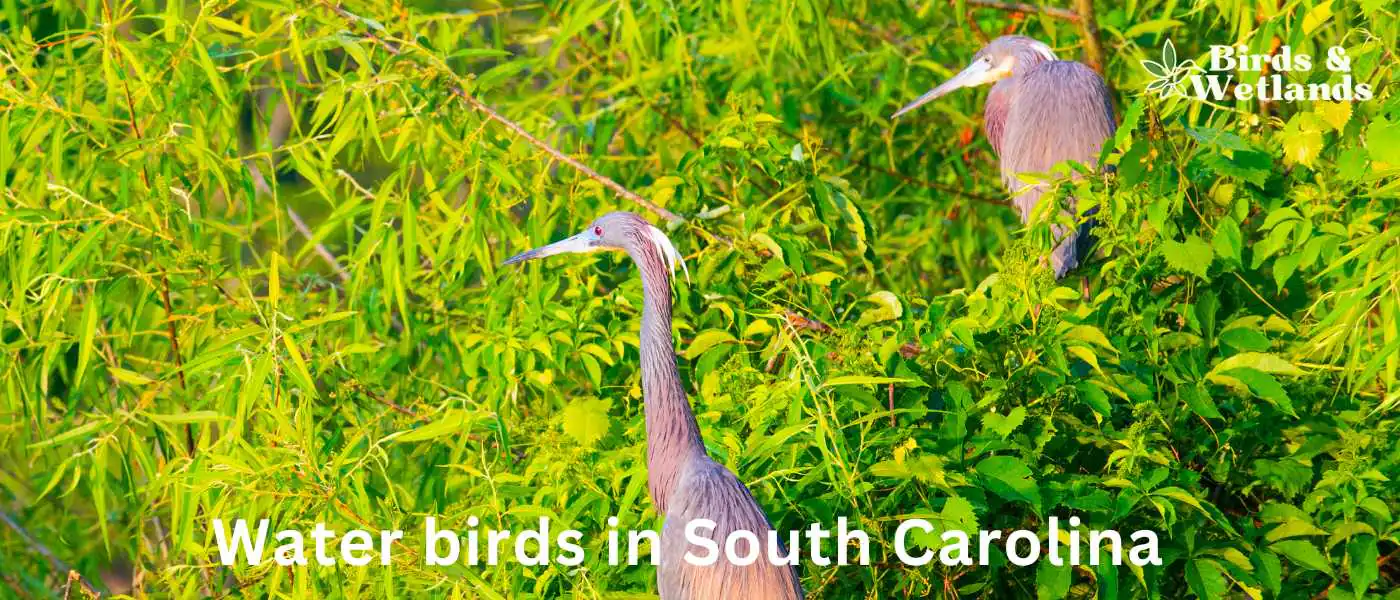South Carolina, with its warm climate, diverse habitats, and miles of coastline, is a haven for a multitude of water birds. From its sun-drenched beaches to its swampy marshlands, the state supports an incredible array of 27 distinct water bird species.
South Carolina water birds
South Carolina, with its rich mix of coastal areas, wetlands, and lakes, offers diverse habitats for a variety of water birds. Here are 25 of the most common species you might encounter in the state:
| Bird Species | Commonality | Best Location to Find |
|---|---|---|
| Mallard | Very common | Swan Lake Iris Gardens |
| Canada Goose | Very common | Lake Murray |
| Great Blue Heron | Very common | Huntington Beach State Park |
| Snowy Egret | Common | Cape Romain National Wildlife Refuge |
| Brown Pelican | Very common | Hilton Head Island |
| American White Pelican | Common | Santee National Wildlife Refuge |
| Double-crested Cormorant | Very common | Charleston Harbor |
| Reddish Egret | Common | Dewees Island |
| Wood Duck | Common | Magnolia Plantation and Gardens |
| Northern Shoveler | Common | Bear Island Wildlife Management Area |
| Blue-winged Teal | Common | Savannah National Wildlife Refuge |
| Pied-billed Grebe | Common | Lake Conestee Nature Park |
| American Coot | Very common | Lake Murray |
| American Black Duck | Common | Santee Coastal Reserve |
| Least Bittern | Common | Congaree National Park |
| Belted Kingfisher | Common | Myrtle Beach State Park |
| Laughing Gull | Very common | Folly Beach |
| Herring Gull | Very common | Myrtle Beach |
| Osprey | Common | Lake Moultrie |
| Red-tailed Hawk | Common | Santee State Park |
| Green Heron | Common | Cypress Gardens |
| Anhinga | Very common | ACE Basin National Wildlife Refuge |
| White Ibis | Common | Kiawah Island |
| Roseate Spoonbill | Common | Bulls Island |
| Black Skimmer | Common | Sullivan’s Island |
Water Bird Species Found in South Carolina
Mallard


| Feature | Measurement |
|---|---|
| Scientific Name | Anas platyrhynchos |
| Length | 20-26 inches |
| Wingspan | 32-39 inches |
| Weight | 1.6-3.5 pounds |
The Mallard, one of the most recognizable of all ducks, is distinguished by its classic “quack” and its common presence in city parks and wild wetlands.
Appearance: Mallards are large ducks with a hefty body and rounded head. The male is notable for its glossy green head, gray body, and black tail-curl, while the female is mottled brown with an orange-brown bill. Both sexes have a white-bordered, blue “speculum” patch in the wing.
Diet: Mallards are omnivorous, dabbling ducks that eat a wide variety of foods. They are known to feed on aquatic vegetation, insects, worms, and grains. In city parks, they are often seen eating bread, popcorn, and other food provided by humans, although such items are not part of their natural diet.
Reproduction: Mallards nest on the ground on dry land that is close to water, under cover of tall grass or other vegetation. The female typically lays around 8 to 13 eggs and incubates them herself.
Canada Goose
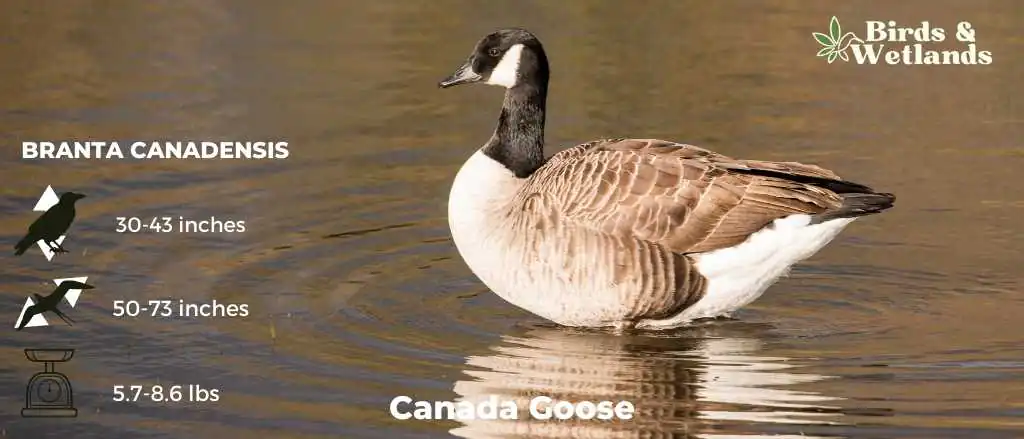

Canada Goose Sound
Scientific Name: Branta canadensis
Length: 30 to 43 in
Wingspan: 50–73 in
Weight: 5.7–14.3 lb
The Canada Goose is a large, well-known species of waterfowl noted for its distinctive appearance, familiar “honk,” and migratory behavior.
Appearance: Both male and female Canada Geese have a similar appearance, featuring a black head and neck with distinctive white patches on the cheeks and chin. The body is primarily brown with a lighter, often white, underbelly.
Diet: Canada Geese primarily feed on plant matter, including grasses, aquatic vegetation, and grains. They can often be seen grazing in parks, lawns, and fields, as well as dabbling in water bodies.
Reproduction: Canada Geese typically nest on the ground near water bodies, often on islands or other isolated areas to avoid predators. The female lays a clutch of about 4 to 6 eggs, which she incubates alone for around a month.
Great Blue Heron


| Feature | Measurement |
|---|---|
| Scientific Name | Ardea herodias |
| Length | 36–54 in |
| Wingspan | 66–79 in |
| Weight | 1.82–3.6 kgs |
Great Blue Herons are the largest heron species in North America, is distinguished by its tall stature and unique blue-gray plumage.
Measuring up to 4.5 feet tall with a wingspan of approximately 6.5 feet, the bird features a long, pointed bill, a white head with a black eye stripe extending to slender black plumes, and robust, elongated legs. Its distinctive flight pattern, forming a tight “S” shape with its neck, sets it apart from similar large birds, like cranes.
Inhabiting various wetland habitats, including marshes, lakes, rivers, and coastal regions throughout much of North and Central America, the Great Blue Heron is a wading bird. Often seen poised statue-like at the water’s edge, these birds are expert hunters, spearing fish and capturing small animals with their sharp bills.
Snowy Egret

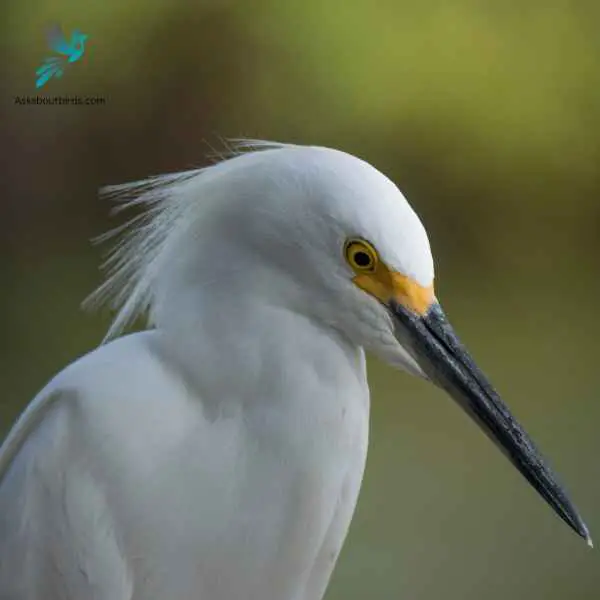
| Feature | Measurement |
|---|---|
| Scientific Name | Egretta thula |
| Length | 22.1–26.0 in |
| Wingspan | 39.4 in |
| Weight | 370 g |
The Snowy Egret (Egretta thula) is a small and active wading bird, celebrated for its delicate beauty. It sports an entirely white plumage that appears to glow against its black bill and legs, and striking yellow feet, which often play a crucial role in luring prey during feeding.
The Snowy Egret is further adorned with fine, plume-like feathers on its head, neck, and back during the breeding season, making it one of the more distinctive heron species.
Inhabiting wetland areas across the Americas, the Snowy Egret can be found in marshes, swamps, shorelines, and tidal flats where it feeds primarily on fish, but also consumes insects, crustaceans, and small reptiles.
Brown Pelican (Pelecanus occidentalis)
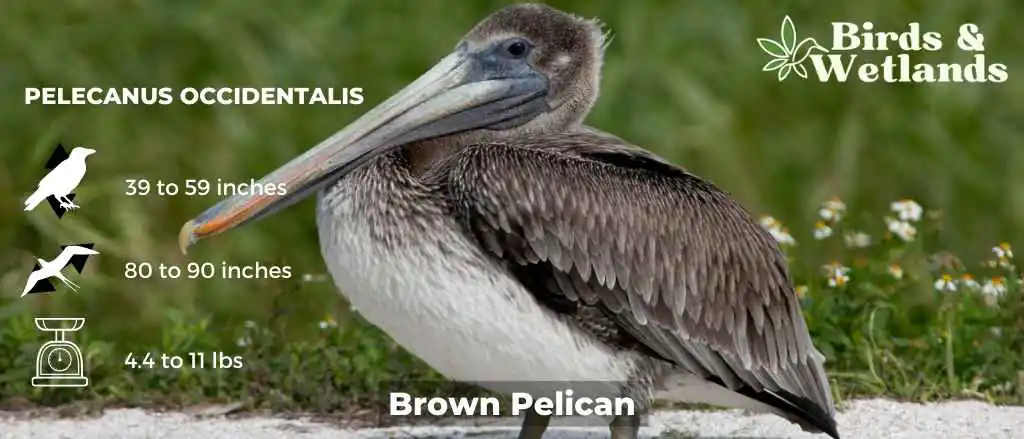
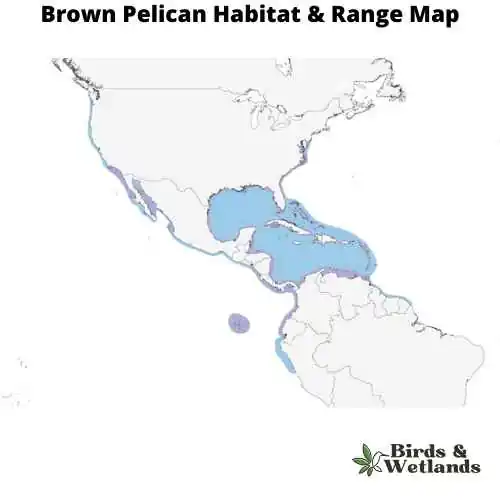
Listen:
Scientific Name: Pelecanus occidentalis
Length: 3 ft 3 in to 5 ft 0 in
Wingspan: 6 ft 8 in to 7 ft 6 in
Weight: 4.4 to 11.0 lb
The Brown Pelican is a large water bird famous for its distinct body shape and dramatic feeding habits. Known for their habit of diving headfirst into the water to catch fish, they are a staple along the coasts of the southern United States.
Appearance: Brown Pelicans are easily identifiable due to their long, curved necks, stout bodies, and large bills with a stretchy pouch. As their name suggests, they have brown and gray body feathers, with a paler head and neck that can become yellowish in breeding season.
Diet: Their diet mainly consists of fish, which they catch by making spectacular plunging dives from the air, scooping up the fish in their expandable bill pouches. They then drain the water from their pouches before swallowing their catch.
Reproduction: Brown Pelicans nest in colonies on islands, laying 2 to 3 eggs in nests made from sticks and vegetation. Both parents share incubation and feeding duties. After hatching, the chicks remain in the nest for around 12 weeks before they are ready to leave.
American White Pelican


| Feature | Measurement |
|---|---|
| Scientific Name | Pelecanus erythrorhynchos |
| Length | 50–70 in |
| Wingspan | 95–120 in |
| Weight | 3.5 and 13.6 kg |
The American White Pelican (Pelecanus erythrorhynchos) is one of North America’s largest birds, distinguished by its brilliant white plumage, elongated orange bill, and massive wingspan, which can extend up to 3 meters. This bird has a unique appearance with its distinctive pouch used for feeding and a “horn” on the upper part of the bill during the breeding season. Though a large bird, it is very graceful in flight, often seen soaring in flocks in a V formation.
American White Pelicans inhabit lakes, marshes, and salt bays, and despite their size, they are excellent swimmers. They feed primarily on fish, using a cooperative hunting strategy where they encircle schools of fish in shallow water and then scoop them up in their bill pouches. Unlike their brown pelican relatives, they do not dive for their food. During the breeding season, these pelicans will nest in colonies on islands in freshwater lakes.
Double-crested cormorant


| Feature | Measurement |
|---|---|
| Scientific Name | Nannopterum auritum |
| Length | 28–35 in |
| Wingspan | 45–48 in |
| Weight | 1.2–2.5 kg |
The Double-Crested Cormorant (Phalacrocorax auritus) is a large waterbird known for its long neck, hooked bill, and almost entirely black body. The species gets its name from the two small patches of tufted feathers or “crests” found on the heads of breeding adults, one on each side. These birds are strong swimmers that propel themselves underwater with their webbed feet, their bodies submerged and necks above the water surface, giving them a characteristic snake-like appearance when swimming.
Double-Crested Cormorants are widely distributed across North America and can be found in a variety of aquatic environments including freshwater lakes, coastal areas, and rivers. Their diet primarily consists of fish, which they catch by diving from the water’s surface. Often seen perched with wings outstretched to dry after fishing, these cormorants nest in trees, on the ground, or on cliff edges, usually in colonies. While they have rebounded from decreases in the mid-20th century due to DDT-related reproductive failures, they face ongoing threats from habitat loss, entanglement in fishing gear, and conflicts with fisheries over their consumption of fish. Protection and careful management of their habitats are key to their ongoing conservation.
Reddish Egret

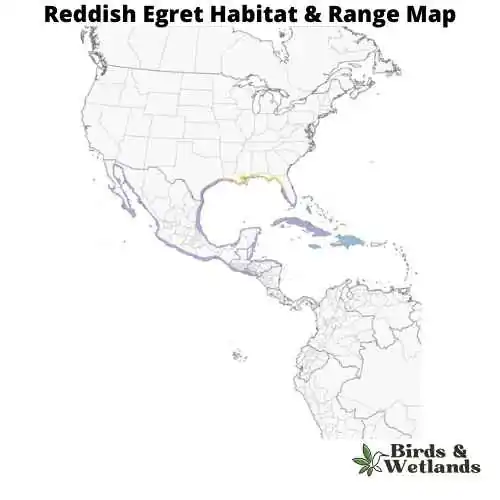
Listen:
Scientific Name: Egretta rufescens
Length: 27–32 in
Wingspan: 46–49 in
Weight: 0.802–1.918 lb
The Reddish Egret is a large wading bird admired for its reddish plumage and active hunting behavior.
Appearance: Reddish Egrets are notable for their gray body and reddish neck and head. They also possess a distinctive shaggy appearance, with elongated neck and body feathers. There are also white morphs of the species that are entirely white.
Diet: Reddish Egrets primarily feed on fish, but they also eat amphibians and crustaceans. They are known for their dynamic hunting style, often running, jumping, and spinning in the shallows to chase their prey.
Reproduction: Reddish Egrets nest in colonies, usually on islands populated by other wading birds. The nests are built in shrubs or trees, with the female laying a clutch of about 3 to 4 eggs.
Wood Duck
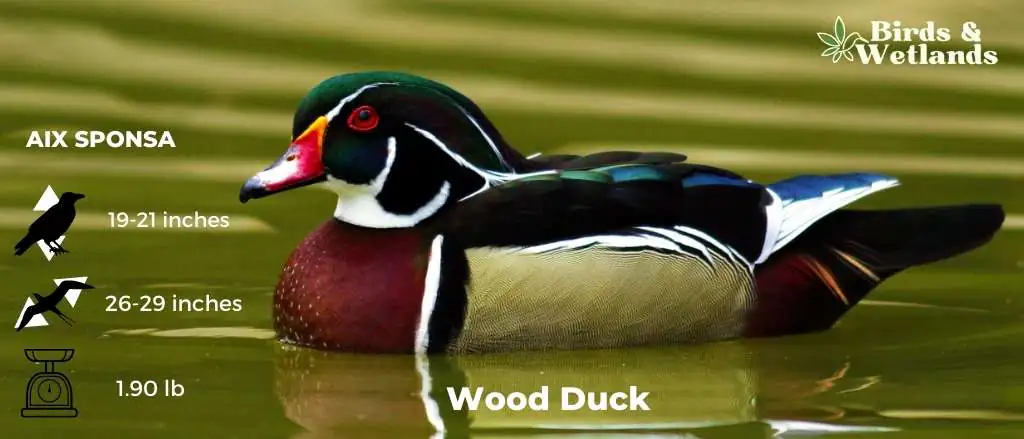

Listen:
Scientific Name: Aix sponsa
Length: 19 to 21 in
Wingspan: 26 to 29 in
Weight: 16.0-30.4 oz
The Wood Duck is an exquisitely colorful waterfowl known for its unique nesting habits and is commonly seen in wooded swamps, marshes, and streams across North America.
Appearance: With their dazzling plumage, Wood Ducks are among the most stunning birds. Males display a multitude of colors, including a green and purple crested head, red eyes, and a white-striped chest, all contrasted with a bronze-colored body. Females, though more subdued with a gray-brown body and white eye-ring, also possess their own charm.
Diet: Wood Ducks have a diverse diet that includes seeds, fruits, and insects, as well as other invertebrates. Their broad diet helps them to adapt to a variety of habitats, whether in the wild or in urban areas with suitable nesting sites.
Reproduction: Unlike most other ducks, Wood Ducks prefer to nest in tree cavities near water, leading to their common name. They will also readily use nest boxes if they’re available. A typical clutch consists of 9 to 14 eggs, which the female incubates alone.
Northern Shoveler
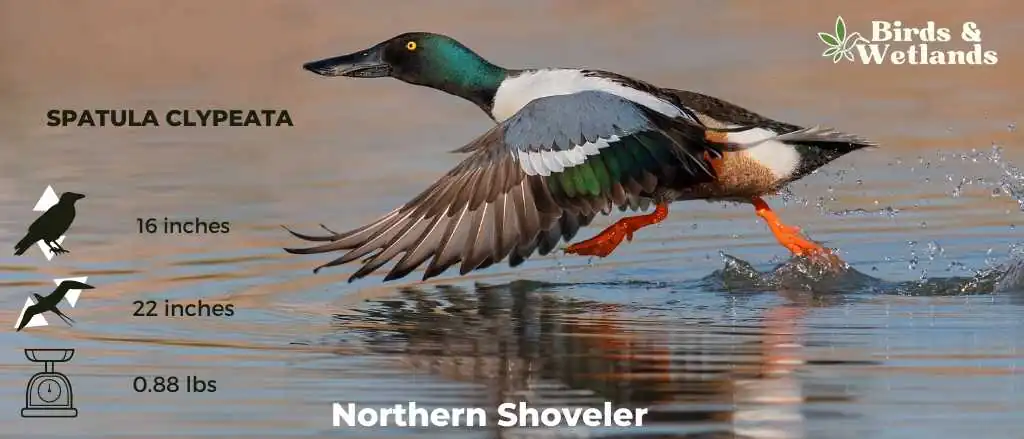
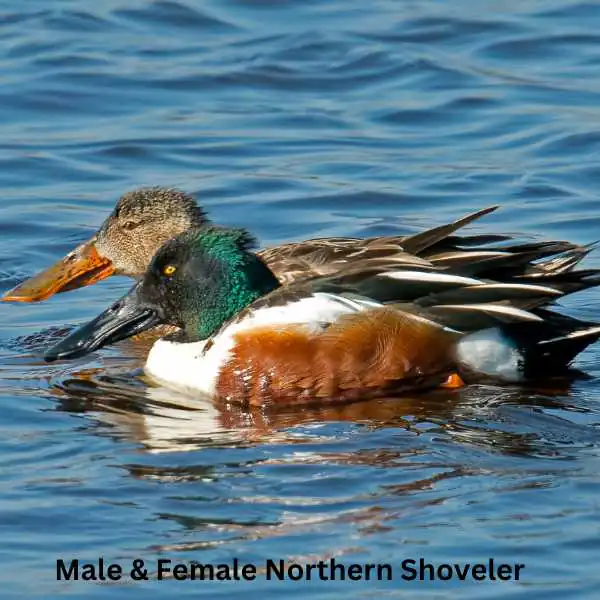
Listen to Northern Shoveler
Scientific Name: Spatula clypeata
Length: 16 in
Wingspan: 22 in
Weight: 14 oz
The Northern Shoveler is a distinct species of dabbling duck celebrated for its long, spoon-shaped bill, a feature that sets it apart from other ducks and gives the bird its name.
Appearance: Male Northern Shovelers are particularly striking, boasting a green head, yellow eyes, a large black bill, and a white chest, complemented by a chestnut-colored body. Females, on the other hand, feature a more muted color scheme, primarily displaying mottled brown feathers across their bodies and a slate-gray bill.
Diet: The Northern Shoveler’s unique bill is perfectly adapted for its feeding habits. The edges of the bill are furnished with comb-like structures that enable the bird to filter food from water. Their diet predominantly consists of aquatic invertebrates and plant matter, including seeds and algae.
Reproduction: Northern Shovelers typically nest on the ground, concealed within dense, grassy areas close to water bodies. The female lays a clutch of about 9 to 12 eggs and is solely responsible for their incubation, which lasts for about three to four weeks.
Blue-winged Teal
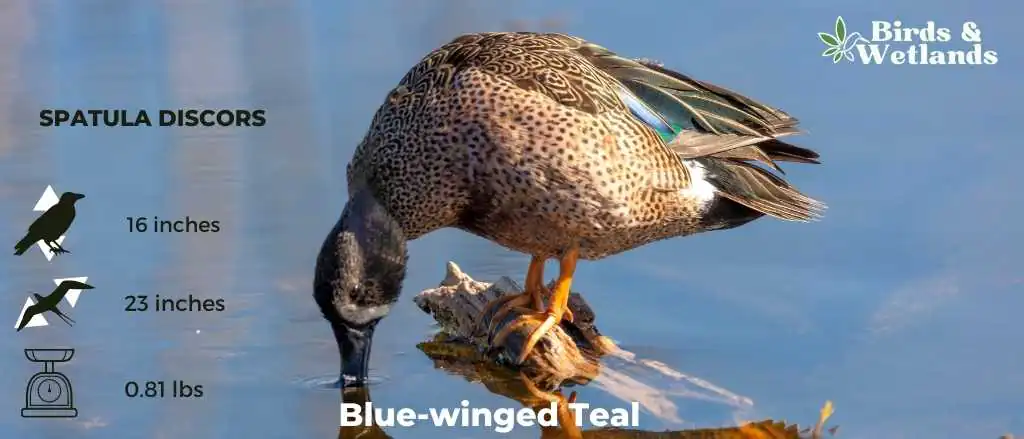

Listen to Blue-winged Teal
Scientific Name: Spatula discors
Length: 16 in
Wingspan: 23 in
Weight: 13 oz
The Blue-winged Teal is a small species of dabbling duck known for its striking plumage and its extensive migratory habits.
Appearance: Male Blue-winged Teals are quite colorful, with a slate gray head and neck, a white crescent in front of the eyes, and a predominantly brown body with specks of black. The name “Blue-winged” comes from the patch of blue feathers visible on their wings during flight. Females, in contrast, are primarily brown and subtly mottled to provide camouflage.
Diet: The Blue-winged Teal feeds mainly on plant matter, such as seeds and aquatic vegetation. However, they also supplement their diet with small invertebrates, especially during the breeding season. They are known for their “dabbling” behavior, where they feed at the surface of the water rather than diving.
Reproduction: Blue-winged Teals prefer to nest on the ground in grassy areas near water. The female typically lays a clutch of 9 to 13 eggs, which she incubates alone for about three weeks. After hatching, the ducklings can feed themselves but remain under the mother’s protection until they are capable of flying.
Pied-billed Grebe
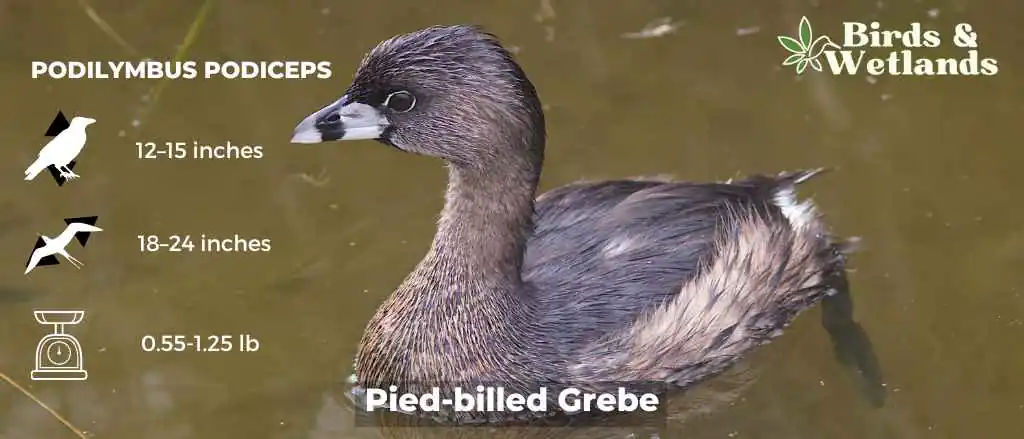

Listen:
Scientific Name: Podilymbus podiceps
Length: 12–15 in
Wingspan: 18–24 in
Weight: 8.9–20.0 oz
The Pied-billed Grebe is a small, elusive water bird well-known for its unique ability to adjust its buoyancy and often “sink” out of sight. It can be found in a wide variety of wetland habitats across the United States.
Appearance: Pied-billed Grebes have a stocky build with a short neck and a chicken-like bill that is conspicuously ringed in black during the breeding season – hence the name “pied-billed”. Their plumage is primarily a muted brown, which can vary in tone depending on the season.
Diet: Their diet consists predominantly of aquatic invertebrates, small fish, and amphibians. Pied-billed Grebes are adept divers and can stay underwater for impressive lengths of time to catch their prey.
Reproduction: Pied-billed Grebes usually nest in dense marsh vegetation, where the female lays 5 to 7 eggs. Both parents share responsibilities for incubation. After hatching, the chicks are often seen riding on their parents’ backs while they learn to navigate their aquatic world.
American Coot
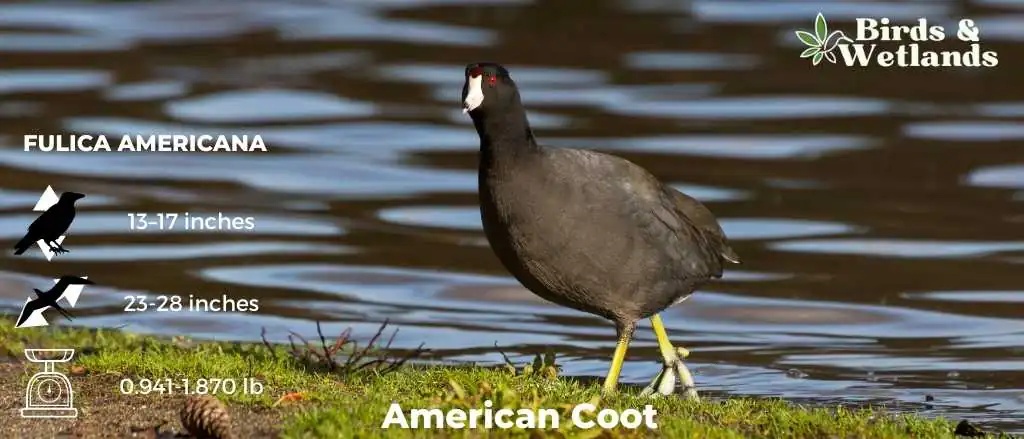
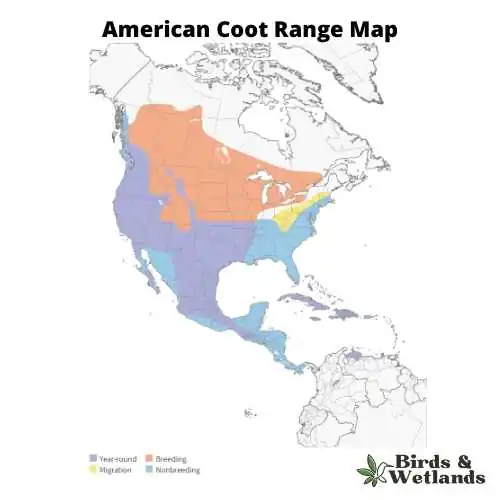
Listen:
Scientific Name: Fulica americana
Length: 13–17 in
Wingspan: 23 to 28 in
Weight: 1.270 to 1.870 lb
The American Coot is a ubiquitous water bird commonly seen in the wetlands, lakes, and ponds of North America, recognized for its adaptability and striking features.
Appearance: American Coots are easily identifiable by their slate-gray bodies, offset by a white, chicken-like bill and a red eye. Their legs are also distinctive, equipped with lobed toes, as opposed to the webbed feet seen in ducks, which assist them in navigating both land and water adeptly.
Diet: While aquatic plants form the bulk of an American Coot’s diet, they aren’t strictly herbivores. These versatile birds also consume small invertebrates and fish, demonstrating their ability to adapt and survive in a variety of habitats.
Reproduction: Nesting for the American Coot usually happens in shallow water bodies, where they construct a floating nest hidden among the vegetation. A clutch can contain between 8 to 12 eggs, all of which are incubated by both parents.


Listen
Scientific Name: Anas rubripes
Length: 21–23 in
Wingspan: 35–37 in
Weight: 1.59–3.62 lb
The Black Duck is a relatively large species of waterfowl known for its dark plumage and distinctive, richly flavored meat.
Appearance: Both male and female Black Ducks sport a similar look. They are predominantly dark brown in color with a lighter, beige-colored underbelly. They feature a yellowish-green bill, and their wings, when spread, reveal a purple-blue speculum bordered by two black bands.
Diet: Black Ducks primarily subsist on plant matter. They feed on seeds, leaves, and roots of aquatic plants, as well as grasses and crops. In addition, they sometimes eat small fish, insects, and aquatic invertebrates. These ducks can often be spotted foraging in shallow water bodies and marshlands.
Reproduction: Black Ducks typically create their nests on the ground, preferably in secluded, well-hidden spots near water bodies. The female usually lays a clutch of about 6 to 12 eggs, which she incubates for about four weeks.
The Least Bittern (Ixobrychus exilis)
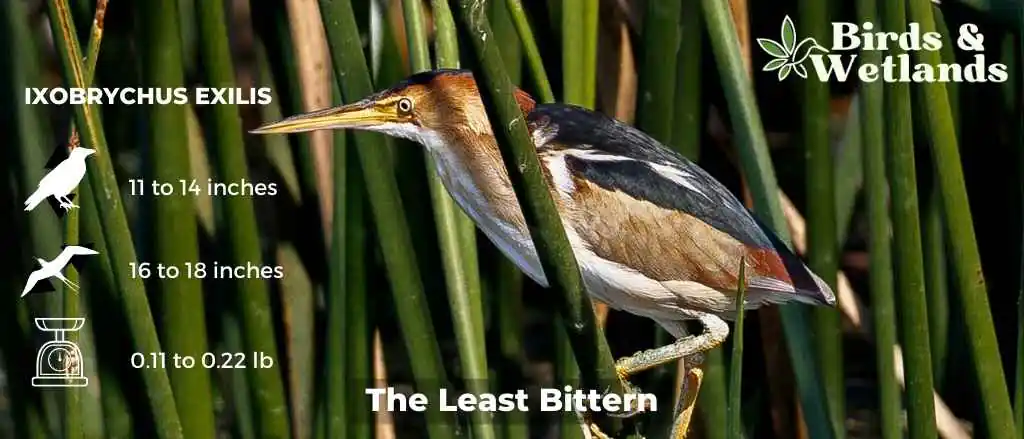
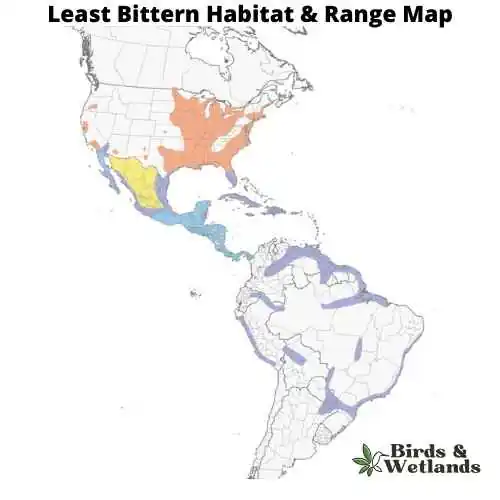
Listen
Scientific Name: Ixobrychus exilis
Length: 11 to 14 in
Wingspan: 16 to 18 in
Weight: 1.8 to 3.6 oz
The Least Bittern is a small and secretive water bird species that often goes unnoticed in its marshy habitat due to its cryptic behaviors and coloring.
Appearance: The Least Bittern is a compact bird with a hunched posture and short neck. It features a mix of buffy and brown coloration on its upper parts, while its chest and neck are more of a pale, buffy color. The males have darker backs and caps than the females. A distinctive feature of this bird is its yellow eyes.
Diet: The Least Bittern’s diet consists mainly of small fish and invertebrates. They forage by stalking slowly through their marshy habitat and striking out with a swift jab of their bill to snatch their prey.
Reproduction: Least Bitterns are solitary nesters, often hiding their nests in dense wetland vegetation. The female lays between 4 to 7 eggs and both parents participate in incubation and feeding.
Belted Kingfisher (Megaceryle alcyon)

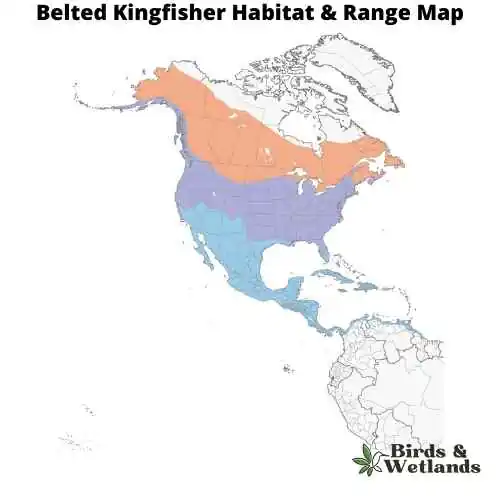
Listen
Scientific Name: Megaceryle alcyon
Length:11–14 in
Wingspan: 19–23 in
Weight: 4.0 to 6.3 oz
The Belted Kingfisher is a conspicuous water bird, known for its distinct rattling call and impressive diving abilities.
Appearance: The Belted Kingfisher is characterized by a large head with a shaggy crest and a long, thick bill. They have a blue-gray body with white underparts. A defining characteristic is the blue-gray band, or “belt,” across the chest. Males and females have similar coloration, but females have an additional chestnut-colored band on their bellies.
Diet: Belted Kingfishers are excellent fishermen, often seen perched above water bodies, such as rivers, streams, lakes, and ponds, watching for their prey. They primarily feed on fish but will also eat amphibians, crustaceans, insects, small mammals, and reptiles. They hunt by diving headfirst into the water to catch their prey.
Reproduction: Belted Kingfishers nest in burrows that they excavate in sandy or earthy banks, usually near a body of water. These burrows can be up to 8 feet deep. The female lays a clutch of 5 to 8 eggs, and both parents participate in incubation and feeding of the young.
Laughing Gull (Leucophaeus atricilla)
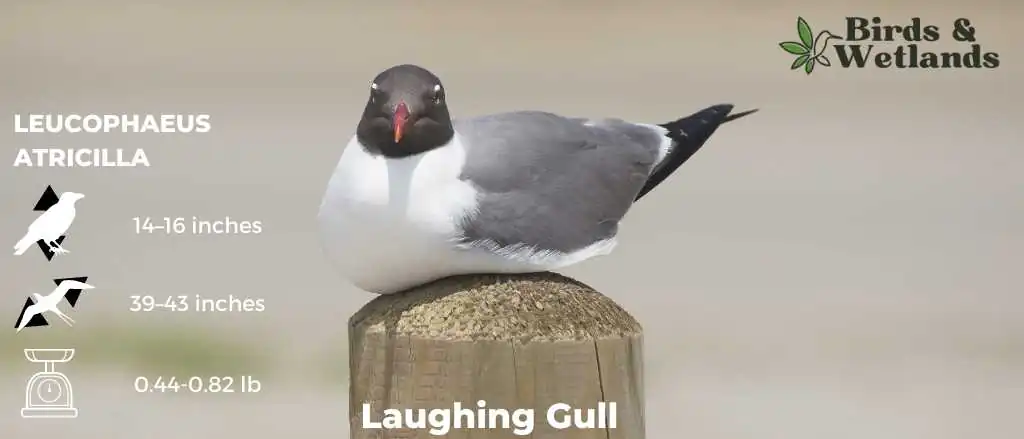
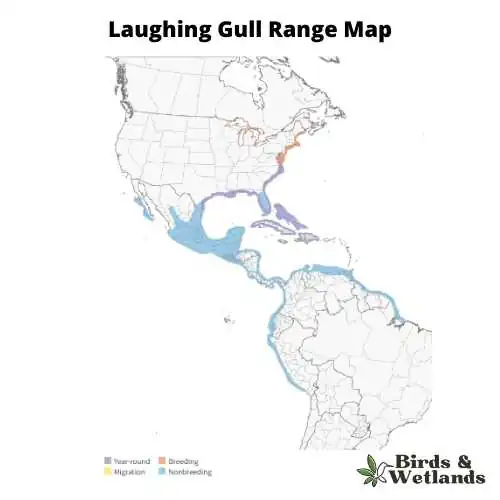
Listen:
Scientific Name: Leucophaeus atricilla
Length: 14–16 in
Wingspan: 39–43 in
Weight: 7.2-13.1 oz
The Laughing Gull is a medium-sized coastal gull that’s notable for its distinctive call that sounds like a high-pitched laugh, giving the bird its common name.
Appearance: Adult Laughing Gulls have a dark, almost black, head in the summer, with a grey body and black wingtips. In the winter, their heads turn white with a smoky gray mask. Their legs are reddish-black, and they have a long, red bill.
Diet: Laughing Gulls are omnivores, eating a varied diet that includes fish, insects, invertebrates like shrimp and crabs, and sometimes even human food waste. They are opportunistic feeders and are often seen foraging in garbage bins in coastal towns.
Reproduction: The Laughing Gull nests in large, noisy colonies. The female typically lays 2 to 4 eggs in a nest constructed from grass, sticks, or seaweed on the ground, often on islands. Both parents take turns incubating the eggs, and after they hatch, the chicks stay in the nest for about 20 days before taking their first flight.
Herring Gull (Larus argentatus)


Listen:
Scientific Name: Larus argentatus
Length: 22.1-26.0 in
Wingspan: 53.9–57.5 in
Weight: 28.2-44.1 oz
The Herring Gull is a versatile bird often found near coastlines, known for its distinct call and adaptive lifestyle.
Appearance: Herring Gulls have a white body, gray back, and yellow bill with a red spot. Juvenile gulls are brown, becoming whiter as they age.
Diet: These gulls are opportunistic eaters. They consume a variety of food, including fish, insects, small birds, carrion, and human refuse.
Reproduction: Herring Gulls nest in colonies on islands or cliffs, laying two to three eggs per season. Both parents share incubation and chick-raising responsibilities.
Osprey (Pandion haliaetus)

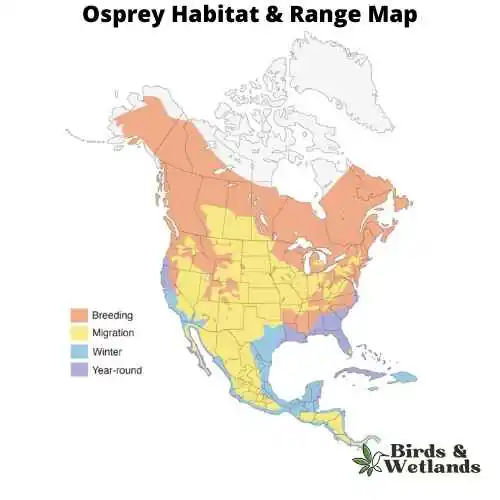
Osprey Sound
Scientific Name: Pandion haliaetus
Length: 50–66 cm (19+1⁄2–26 in)
Wingspan: 127–180 cm (50–71 in)
Weight: 0.9–2.1 kg (2 lb 0 oz – 4 lb 10 oz)
The Osprey, a fascinating bird of prey, is universally known for its exceptional hunting prowess and striking physical characteristics. Osprey are dark brown hawks on the upperparts, contrasting beautifully with the predominantly white underparts, and a distinctive dark band that stretches across the eyes towards the sides of its head.
Equipped with specialized talons and a reversible outer toe, the Osprey’s hunting strategy involves a spectacular plunge-dive into bodies of water, often emerging with a fish securely gripped in its claws.
Found on every continent except Antarctica, the Osprey is a cosmopolitan species favoring habitats near water bodies such as lakes, rivers, and coastal areas, reflecting its piscivorous diet. This bird has a diet almost exclusively of fish, making it a unique member of the raptor family and often referred to as the sea hawk or fish hawk. They locate their prey from the air, often hovering before plunging feet-first to capture a fish. When it comes to breeding, Ospreys are monogamous, often mating for life.
They construct large, bulky nests made of sticks, lined with softer materials, and prefer elevated or isolated areas such as treetops or artificial structures like utility poles. Both parents share the responsibility of incubating the eggs and rearing the chicks.
Red-tailed Hawk (Buteo jamaicensis)

The Red-tailed Hawk is a large bird of prey that is commonly found across North America. This species is part of the genus Buteo, which is often referred to as the “true hawks,” and includes more than two dozen species of raptors.
Red-tailed Hawks have a robust size, ranging from 18 to 26 inches in length and sporting a wingspan that can exceed 4 feet. They have a broad, rounded set of wings and a short, wide red tail. This species is most easily recognized by its rich, rust-colored tail, which gives it its common name. However, juvenile hawks might not yet have this distinctive feature.
Their feathers are generally dark brown on their dorsal side (back) with a lighter, often speckled, ventral side (front). The intensity and pattern of their plumage can vary significantly based on their age and geographic location, as there are about 14 recognized subspecies of Red-tailed Hawks.
As for their diet, Red-tailed Hawks are carnivores and have a broad diet that includes rodents, ground rabbits, reptiles, and other birds. They are skilled hunters that typically sit on high perches and use their keen eyesight to spot potential prey. Once they have identified a target, they swoop down to capture it with their powerful talons.
Red-tailed Hawks mate for life and build nests high off the ground, often in tall trees or on cliff edges. Their nests are made of sticks and can be quite large. They typically lay 1-3 eggs per year, which are incubated by both parents.
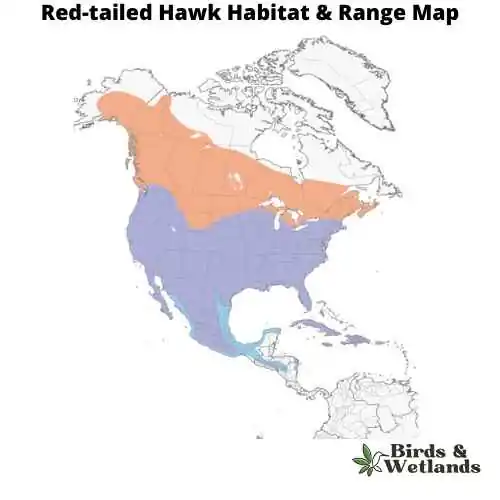
Red-tailed Hawk Sound
Green Heron


| Feature | Measurement |
|---|---|
| Scientific Name | Butorides virescens |
| Length | 16-18 inches |
| Wingspan | 25-27 inches |
| Weight | 6-7 ounces |
The Green Heron is a small heron found in North America, notable for its deep green back and chestnut body, as well as its unique fishing tactics.
Appearance: Green Herons are dark and compact birds with a glossy, greenish-black cap, a greenish back and wings, and chestnut neck and belly. The bill is long, dark and sharply pointed. Their legs are bright orange or yellow. Young birds are duller in color, with a dark top and streaked brown front.
Diet: The Green Heron’s diet is quite varied, consisting mostly of small fish, but also includes insects, spiders, and sometimes amphibians and small mammals. It’s known for its tool-using behavior where it drops bait onto the water’s surface to attract fish.
Reproduction: Green Herons are solitary birds except during the breeding season, where they form monogamous pairs. Nests are typically built in trees or shrubs near water. Females lay 2 to 5 pale blue-green eggs that both parents incubate.
Anhinga (Anhinga anhinga)

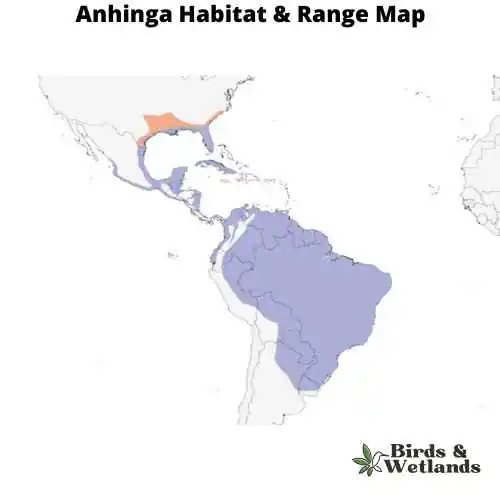
Listen
Scientific Name: Anhinga anhinga
Length: 35 in
Wingspan: 3.7 ft
Weight: 2.7 lb
The Anhinga is a distinctive water bird commonly found in the southern parts of the United States. It is often referred to as the “snakebird” because of its long neck, which often protrudes from the water while the rest of its body is submerged.
Appearance: The Anhinga has a slim body with a long neck and a pointed bill. The males are dark overall with silver wing patches, while females have a pale head, neck, and upper chest contrasting with a dark lower body. When in flight, the Anhinga’s long tail and broad wings are noticeable.
Diet: Anhingas are carnivorous birds primarily feeding on fish. They are excellent divers and often swim submerged, with only their neck visible above water, stalking their aquatic prey. They also eat other aquatic creatures such as insects, crustaceans, and amphibians.
Reproduction: Anhingas breed in colonies, often with other water birds. They build stick nests in trees or shrubs near water. The female lays 2 to 4 eggs that are incubated by both parents for about 25 to 30 days. The young are cared for by both parents and start to fly after about six weeks.
White Ibis (Eudocimus albus)
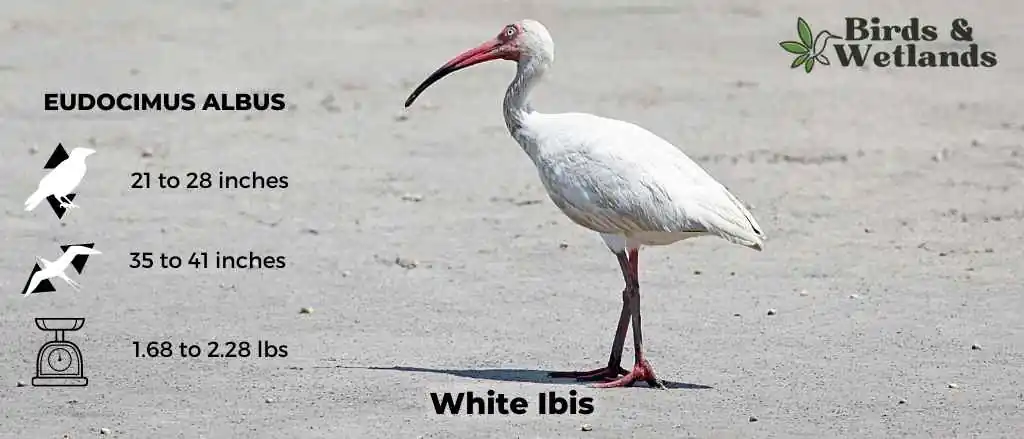

Listen:
Scientific Name: Eudocimus albus
Length: 21 to 28 in
Wingspan: 35 to 41 in
Weight: 1.6 – 2.3lb
The White Ibis is a wading bird renowned for its bright white plumage and distinctive, down-curved bill. It’s most commonly found in the marshes, wetlands, and along the coastlines of the southeastern United States.
Appearance: White Ibises display a predominantly white plumage that’s contrasted by their brilliant red-orange down-curved bill and legs. During the breeding season, the skin on their face may become dark blue. Juvenile White Ibises have brown upper parts and white underparts.
Diet: The diet of the White Ibis primarily consists of various invertebrates, including insects, crayfish, and other small crustaceans. Their long, curved bill is perfectly adapted for probing in mud and shallow water while foraging for food.
Reproduction: White Ibises nest in large colonies, often with other wading birds. The female typically lays 2 to 4 eggs in a nest made of twigs and leaves in trees or shrubs.
Roseate Spoonbill (Platalea ajaja)


Listen:
Scientific Name: Platalea ajaja
Length: 28–34 in
Wingspan: 47–52 in
Weight: 2.6–4.0 lb
The Roseate Spoonbill is a large, colorful bird native to the Americas, primarily seen in the southern and coastal areas of the United States.
Appearance: Roseate Spoonbills are notable for their pink plumage and spatulate bill. They stand out with their bright pink wings and tail, while their neck and back are a paler, almost white, shade. The bill, broad and flat at the tip like a spoon, is gray, and their legs are a light pink to red color. They also have a bare, greenish head which becomes more colorful during the breeding season.
Diet: Roseate Spoonbills have a diverse diet primarily composed of small fish, crustaceans, and aquatic insects. They feed by sweeping their spoon-like bills back and forth in the water, snapping it shut when they feel prey.
Reproduction: Roseate Spoonbills nest in colonies, often with other water birds. They build nests in shrubs or trees, close to the water. The female typically lays 2 to 3 white, brown-marked eggs. Both parents share incubation duties, which lasts about 22 to 24 days. The chicks are fed by both parents and leave the nest after 5 to 6 weeks.
Black Skimmer (Rynchops niger)
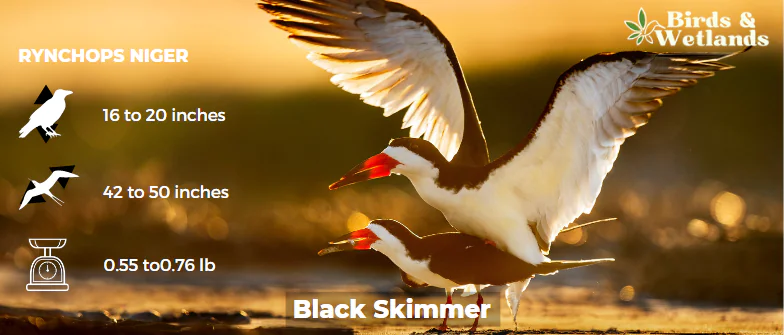
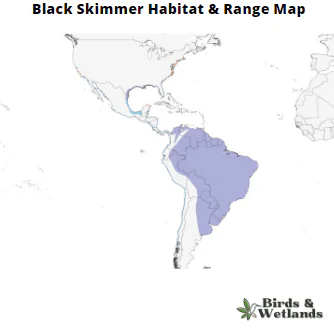
Listen:
Scientific Name: Rynchops niger
Length: 16–20 in
Wingspan: 42–50 in
Weight: 9-12.5oz
The Black Skimmer is a unique coastal bird recognizable for its unusual feeding method, giving it a fascinating presence on the beaches and sandbars it calls home.
Appearance: The Black Skimmer sports a stark contrast in color with a black upper body and white lower body. Its most distinctive feature is its bill, which is knife-thin, bright red at the base, and black at the tip. The bird’s lower mandible is much longer than the upper, an adaptation for its unique feeding style.
Diet: As its name suggests, the Black Skimmer feeds by skimming the surface of water bodies with its elongated lower mandible to catch small fish and crustaceans. It mainly feeds at dawn and dusk, relying on touch to sense prey, making it one of the few birds to feed in near darkness.
Reproduction: Black Skimmers nest in colonies on sandbars, beaches, or dredge spoil islands, with both parents sharing incubation duties. The female lays 1 to 5 eggs, which are then incubated for about 23 days. The chicks are semi-precocial, leaving the nest a few days after hatching but staying nearby for protection and feeding by the parents.
Where to Spot South Carolina’s Water Birds
South Carolina’s diverse landscapes, from its coastlines to its freshwater marshes and saltwater estuaries, provide an array of habitats for water birds. Here are some of the best places to observe them:
Congaree National Park, Hopkins: This biodiverse park is known for its large tract of old-growth bottomland hardwood forest. It’s an excellent place for spotting water birds like Wood Ducks, Belted Kingfishers, and Green Herons.
Santee National Wildlife Refuge, Summerton: Located on the north shore of Lake Marion, it attracts migratory water birds such as Northern Pintails, American Coots, and Ruddy Ducks.
Bear Island Wildlife Management Area, Green Pond: Renowned for its impressive waterfowl populations in winter, you might see a variety of water birds including Snowy Egrets, Great Blue Herons, and Black-crowned Night-Herons.
Ace Basin National Wildlife Refuge, Hollywood: Covering a massive area, the refuge hosts many species of water birds like the Glossy Ibis, White-faced Ibis, and Roseate Spoonbill.
Huntington Beach State Park, Murrells Inlet: This coastal preserve is a must-visit for birdwatchers. From Brown Pelicans to Double-crested Cormorants and American Avocets, the variety of water birds is astounding.
| Neighboring State | Best Spots for Birdwatching |
|---|---|
| Georgia Water Birds | Cumberland Island National Seashore, Harris Neck National Wildlife Refuge, Okefenokee Swamp |
| North Carolina Water Birds | Pea Island National Wildlife Refuge, Cape Hatteras National Seashore, Mattamuskeet National Wildlife Refuge |

